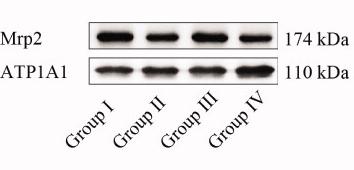ABCC2 Antibody - #DF3873
| 製品: | ABCC2 Antibody |
| カタログ: | DF3873 |
| タンパク質の説明: | Rabbit polyclonal antibody to ABCC2 |
| アプリケーション: | WB IF/ICC |
| Cited expt.: | WB |
| 反応性: | Human, Mouse, Rat |
| 予測: | Pig, Bovine, Horse, Sheep, Rabbit, Dog, Xenopus |
| 分子量: | 174 KD; 174kD(Calculated). |
| ユニプロット: | Q92887 |
| RRID: | AB_2836226 |
製品説明
*The optimal dilutions should be determined by the end user. For optimal experimental results, antibody reuse is not recommended.
*Tips:
WB: For western blot detection of denatured protein samples. IHC: For immunohistochemical detection of paraffin sections (IHC-p) or frozen sections (IHC-f) of tissue samples. IF/ICC: For immunofluorescence detection of cell samples. ELISA(peptide): For ELISA detection of antigenic peptide.
引用形式: Affinity Biosciences Cat# DF3873, RRID:AB_2836226.
折りたたみ/展開
ABC30; abcC2; ATP binding cassette sub family C (CFTR/MRP) member 2; ATP binding cassette subfamily C member 2; ATP-binding cassette sub-family C member 2; Canalicular multidrug resistance protein; Canalicular multispecific organic anion transporter 1; CMOAT; CMOAT1; cMRP; DJS; KIAA1010; MRP 2; MRP2_HUMAN; Multidrug resistance associated protein 2; Multidrug resistance-associated protein 2;
免疫原
A synthesized peptide derived from human ABCC2, corresponding to a region within the internal amino acids.
Expressed by polarized cells in liver, kidney and intestine. The highest expression is found in liver.
- Q92887 MRP2_HUMAN:
- Protein BLAST With
- NCBI/
- ExPASy/
- Uniprot
MLEKFCNSTFWNSSFLDSPEADLPLCFEQTVLVWIPLGYLWLLAPWQLLHVYKSRTKRSSTTKLYLAKQVFVGFLLILAAIELALVLTEDSGQATVPAVRYTNPSLYLGTWLLVLLIQYSRQWCVQKNSWFLSLFWILSILCGTFQFQTLIRTLLQGDNSNLAYSCLFFISYGFQILILIFSAFSENNESSNNPSSIASFLSSITYSWYDSIILKGYKRPLTLEDVWEVDEEMKTKTLVSKFETHMKRELQKARRALQRRQEKSSQQNSGARLPGLNKNQSQSQDALVLEDVEKKKKKSGTKKDVPKSWLMKALFKTFYMVLLKSFLLKLVNDIFTFVSPQLLKLLISFASDRDTYLWIGYLCAILLFTAALIQSFCLQCYFQLCFKLGVKVRTAIMASVYKKALTLSNLARKEYTVGETVNLMSVDAQKLMDVTNFMHMLWSSVLQIVLSIFFLWRELGPSVLAGVGVMVLVIPINAILSTKSKTIQVKNMKNKDKRLKIMNEILSGIKILKYFAWEPSFRDQVQNLRKKELKNLLAFSQLQCVVIFVFQLTPVLVSVVTFSVYVLVDSNNILDAQKAFTSITLFNILRFPLSMLPMMISSMLQASVSTERLEKYLGGDDLDTSAIRHDCNFDKAMQFSEASFTWEHDSEATVRDVNLDIMAGQLVAVIGPVGSGKSSLISAMLGEMENVHGHITIKGTTAYVPQQSWIQNGTIKDNILFGTEFNEKRYQQVLEACALLPDLEMLPGGDLAEIGEKGINLSGGQKQRISLARATYQNLDIYLLDDPLSAVDAHVGKHIFNKVLGPNGLLKGKTRLLVTHSMHFLPQVDEIVVLGNGTIVEKGSYSALLAKKGEFAKNLKTFLRHTGPEEEATVHDGSEEEDDDYGLISSVEEIPEDAASITMRRENSFRRTLSRSSRSNGRHLKSLRNSLKTRNVNSLKEDEELVKGQKLIKKEFIETGKVKFSIYLEYLQAIGLFSIFFIILAFVMNSVAFIGSNLWLSAWTSDSKIFNSTDYPASQRDMRVGVYGALGLAQGIFVFIAHFWSAFGFVHASNILHKQLLNNILRAPMRFFDTTPTGRIVNRFAGDISTVDDTLPQSLRSWITCFLGIISTLVMICMATPVFTIIVIPLGIIYVSVQMFYVSTSRQLRRLDSVTRSPIYSHFSETVSGLPVIRAFEHQQRFLKHNEVRIDTNQKCVFSWITSNRWLAIRLELVGNLTVFFSALMMVIYRDTLSGDTVGFVLSNALNITQTLNWLVRMTSEIETNIVAVERITEYTKVENEAPWVTDKRPPPDWPSKGKIQFNNYQVRYRPELDLVLRGITCDIGSMEKIGVVGRTGAGKSSLTNCLFRILEAAGGQIIIDGVDIASIGLHDLREKLTIIPQDPILFSGSLRMNLDPFNNYSDEEIWKALELAHLKSFVASLQLGLSHEVTEAGGNLSIGQRQLLCLGRALLRKSKILVLDEATAAVDLETDNLIQTTIQNEFAHCTVITIAHRLHTIMDSDKVMVLDNGKIIECGSPEELLQIPGPFYFMAKEAGIENVNSTKF
種類予測
Score>80(red) has high confidence and is suggested to be used for WB detection. *The prediction model is mainly based on the alignment of immunogen sequences, the results are for reference only, not as the basis of quality assurance.
High(score>80) Medium(80>score>50) Low(score<50) No confidence
研究背景
Mediates hepatobiliary excretion of numerous organic anions and conjugated organic anions such as methotrexate, 17beta-estradiol 17-glucosiduronic acid and leukotriene C4. Also transports sulfated bile salt such as taurolithocholate sulfate. May function as a cellular cisplatin transporter.
Apical cell membrane>Multi-pass membrane protein.
Expressed by polarized cells in liver, kidney and intestine. The highest expression is found in liver.
Belongs to the ABC transporter superfamily. ABCC family. Conjugate transporter (TC 3.A.1.208) subfamily.
研究領域
· Environmental Information Processing > Membrane transport > ABC transporters.
· Human Diseases > Drug resistance: Antineoplastic > Antifolate resistance.
· Human Diseases > Drug resistance: Antineoplastic > Platinum drug resistance.
参考文献
Application: WB Species: Rat Sample: liver tissue
Application: WB Species: rat Sample: liver
Application: WB Species: Rat Sample: ileum
Restrictive clause
Affinity Biosciences tests all products strictly. Citations are provided as a resource for additional applications that have not been validated by Affinity Biosciences. Please choose the appropriate format for each application and consult Materials and Methods sections for additional details about the use of any product in these publications.
For Research Use Only.
Not for use in diagnostic or therapeutic procedures. Not for resale. Not for distribution without written consent. Affinity Biosciences will not be held responsible for patent infringement or other violations that may occur with the use of our products. Affinity Biosciences, Affinity Biosciences Logo and all other trademarks are the property of Affinity Biosciences LTD.



